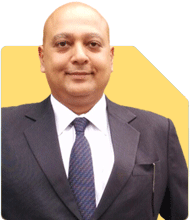Ramalingam Kalirajan |5975 Answers |Ask -Follow
Mutual Funds, Financial Planning Expert - Answered on Jul 15, 2024
He has an MBA in finance from the University of Madras and is a certified financial planner.
He is the director and chief financial planner at Holistic Investment, a Chennai-based firm that offers financial planning and wealth management advice.... more

rediff.com Rediff Gurus Logo Hi Tarun Raj | Sign Out HealthHealth MoneyMoney RelationshipRelationship CareesCareer Ask your questions about health, money, relationship or careers here Ask Anonymously Tarun Tarun 1 Questions 1 Answers 0 Gurus 0 Bookmarks These questions will be answered soon. Not Answered yet Tarun Asked on - Jun 13, 2024 Hello Sir, I am 37 years old and my wife is 35 years old and 1.5 year old daughter. We both collectively earn 305000 Per Month after taxes (Private Job) I have an active home loan of total outstanding of 51 lakh out of 80 lakh (taken 2.5 years back) and currently I am paying 81000 EMI towards that. I have already made repayment of approximately 20 lakh in the past 18 months. Total loan tenure left is around 7.5 years. I have a loan from family members (non interest) 8 lkh which can be repaid as per flexibility. I have 4 LIC Polices for which I am paying 110000 annually and One HDFC ulip plan which is 15K annual. I have approximately 20 lakh in savings (all FDs), we have collective PF balance of 8 lakh and recently I have started investing in mutual funds SIP details are as following 10K SIP - Axis Mid Cap, 5K SIP - Axis small Cap, 5K SIP - HDFC mid Cap opportunity, 2K SIP - Axis Multi Cap. My monthly expenses are around 50000, I would need your suggestion on how to meet my personal financial goal of 5 cr in the next 15 years. I want to make sure I will have substantial funds in hand for My child's education/ Marriage and something for own when we retire. Please advise. Thank you
Let's break down your current financial status:
Income: Rs 3,05,000 per month (combined).
Home Loan: Outstanding Rs 51 lakhs with an EMI of Rs 81,000.
Family Loan: Rs 8 lakhs (interest-free).
Insurance Premiums: Rs 1,10,000 annually for LIC policies and Rs 15,000 for HDFC ULIP.
Savings: Rs 20 lakhs in fixed deposits.
Provident Fund: Rs 8 lakhs combined.
Mutual Funds SIP: Rs 22,000 per month.
Monthly Expenses: Rs 50,000.
You aim to build a corpus of Rs 5 crores in 15 years for your child's education, marriage, and your retirement. Given your income and expenses, this goal is attainable with strategic financial planning.
Optimizing Existing Investments
Review Insurance Policies
You have four LIC policies and one HDFC ULIP plan. While insurance is crucial, these traditional and ULIP policies often provide lower returns compared to mutual funds. Consider the following steps:
Surrender or Convert: Evaluate the surrender value of these policies. It may be beneficial to surrender them and redirect those funds into higher-yielding investments.
Reinvest Premiums: The Rs 1,25,000 annual premium can be reinvested into mutual funds for better returns.
Utilizing Fixed Deposits
You have Rs 20 lakhs in fixed deposits. While FDs are safe, their returns are usually lower than inflation. To grow your wealth, consider the following:
Partial Liquidation: Keep a portion in FDs for emergency funds, but reinvest a significant amount into mutual funds or other higher-yielding instruments.
Strengthening Your Investment Portfolio
Increasing Mutual Fund SIPs
Your current SIPs total Rs 22,000 per month. To reach your Rs 5 crore goal, consider increasing your SIP contributions. Here’s how:
Diversify: Ensure your portfolio has a mix of large-cap, mid-cap, small-cap, and multi-cap funds for balanced growth and risk management.
Step-Up SIPs: Gradually increase your SIP contributions as your income grows. This will help in compounding returns significantly.
Investing in Mutual Funds
Actively managed mutual funds can provide better returns compared to index funds. Here are the benefits:
Active Management: Professional fund managers actively manage these funds, seeking to outperform the market.
Flexibility: Actively managed funds can adjust their portfolio based on market conditions, potentially offering higher returns.
Debt Management
Home Loan Strategy
You have an outstanding home loan of Rs 51 lakhs. Managing this effectively can save you significant interest costs:
Prepay Principal: Use part of your fixed deposits to make lump sum prepayments. This reduces the principal and interest burden.
Reduce EMI or Tenure: Opt to reduce your loan tenure if possible. A shorter tenure can save you substantial interest.
Family Loan Repayment
The Rs 8 lakh family loan is interest-free, giving you repayment flexibility. Prioritize this after addressing high-interest debt and maximizing investments.
Planning for Child's Education and Marriage
Child Education Fund
Start a dedicated investment for your child's education:
Separate SIP: Initiate a separate SIP specifically for education expenses. Estimate future costs and adjust contributions accordingly.
Education Savings Plan: Consider child education plans offered by mutual funds that align with your goals.
Child Marriage Fund
Similarly, plan for your child's marriage:
Long-Term SIP: Start a long-term SIP focused on this goal. Utilize the power of compounding to grow your corpus.
Building Retirement Corpus
Systematic Investment Plan (SIP)
Increase your SIP contributions towards retirement:
Retirement Fund SIP: Set up a separate SIP for retirement, ensuring it aligns with your risk tolerance and time horizon.
Diversify: Include a mix of equity, debt, and hybrid funds for balanced growth and stability.
Provident Fund
Continue contributing to your provident fund. It provides a stable and secure component of your retirement corpus.
Emergency Fund
Maintaining an emergency fund is crucial. Here’s how to build and manage it:
Liquid Funds: Keep a portion of your fixed deposits in liquid mutual funds. They offer better returns than savings accounts and are easily accessible.
3-6 Months Expenses: Ensure your emergency fund covers 3-6 months of your living expenses, including EMIs.
Evaluating and Adjusting Your Plan
Regular Reviews
Financial planning is not a one-time activity. Regularly review and adjust your investments based on market conditions and life changes:
Annual Review: Conduct an annual review with a certified financial planner to ensure your investments are on track.
Adjust SIPs: Adjust your SIP contributions based on changes in income and expenses.
Risk Management
Ensure your investment portfolio aligns with your risk tolerance:
Diversification: Spread investments across various asset classes to mitigate risk.
Insurance: Maintain adequate life and health insurance to protect against unforeseen events.
Final Insights
Your goal of Rs 5 crores in 15 years is ambitious yet achievable with disciplined planning and strategic investments. By optimizing your current investments, increasing SIP contributions, and regularly reviewing your plan, you can secure a substantial corpus for your child's education, marriage, and your retirement.
Focus on diversifying your investments, managing debt efficiently, and maintaining an emergency fund. With consistent efforts and a clear strategy, you will be well-prepared for a financially secure future.
Best Regards,
K. Ramalingam, MBA, CFP,
Chief Financial Planner,
www.holisticinvestment.in
You may like to see similar questions and answers below
Ramalingam Kalirajan |5975 Answers |Ask -Follow
Mutual Funds, Financial Planning Expert - Answered on May 19, 2024
Ramalingam Kalirajan |5975 Answers |Ask -Follow
Mutual Funds, Financial Planning Expert - Answered on Jul 13, 2024
Ramalingam Kalirajan |5975 Answers |Ask -Follow
Mutual Funds, Financial Planning Expert - Answered on Jul 10, 2024
Ramalingam Kalirajan |5975 Answers |Ask -Follow
Mutual Funds, Financial Planning Expert - Answered on Jul 26, 2024
Ramalingam Kalirajan |5975 Answers |Ask -Follow
Mutual Funds, Financial Planning Expert - Answered on Aug 22, 2024
Ramalingam Kalirajan |5975 Answers |Ask -Follow
Mutual Funds, Financial Planning Expert - Answered on Aug 22, 2024
Ramalingam Kalirajan |5975 Answers |Ask -Follow
Mutual Funds, Financial Planning Expert - Answered on Aug 22, 2024
Ramalingam Kalirajan |5975 Answers |Ask -Follow
Mutual Funds, Financial Planning Expert - Answered on Aug 22, 2024
Ramalingam Kalirajan |5975 Answers |Ask -Follow
Mutual Funds, Financial Planning Expert - Answered on Aug 22, 2024
Ramalingam Kalirajan |5975 Answers |Ask -Follow
Mutual Funds, Financial Planning Expert - Answered on Aug 22, 2024
Ramalingam Kalirajan |5975 Answers |Ask -Follow
Mutual Funds, Financial Planning Expert - Answered on Aug 22, 2024
Ramalingam Kalirajan |5975 Answers |Ask -Follow
Mutual Funds, Financial Planning Expert - Answered on Aug 22, 2024
Sushil Sukhwani |500 Answers |Ask -Follow
Study Abroad Expert - Answered on Aug 22, 2024
Ramalingam Kalirajan |5975 Answers |Ask -Follow
Mutual Funds, Financial Planning Expert - Answered on Aug 22, 2024
















